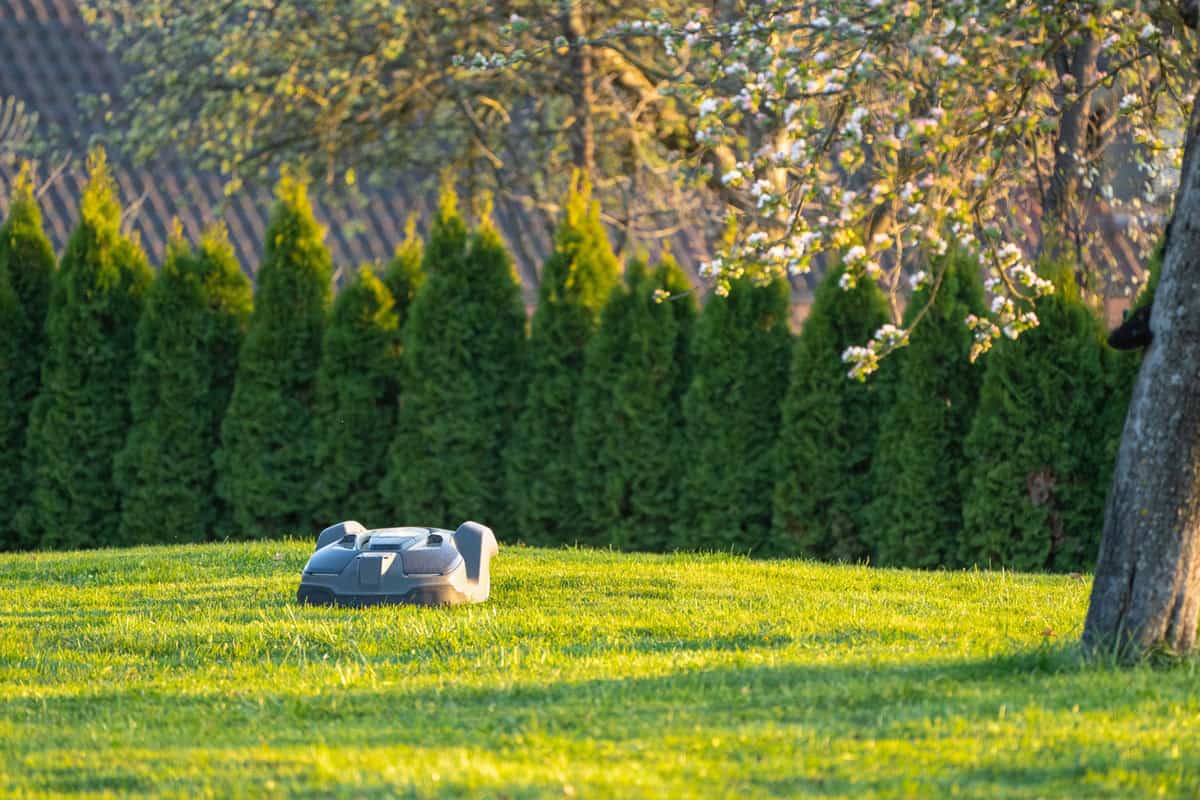Are you thinking about planting some greenery to make a living privacy wall or border? Arborvitae trees are an excellent option for this very purpose. You are probably wondering how close you can plant these evergreen trees to your house or fence. Lucky for you, we researched this very topic so you can know where to plant arborvitae on your property.
To determine how far away from a building or fence to plant an arborvitae shrub, you must first assess its expected mature width. Then, plant your tree half of this distance from any house or fence. Here is a list of recommended planting ranges for different arborvitae varieties used for landscaping purposes:
- American/Eastern: 8 to 10 feet
- Giant/Western: 9 to 11 feet
- Japanese: 6 to 8 feet
- Korean: 6 to 8 feet
- Sichuan: 1 to 2 feet
Keep reading for more information about each of these arborvitae types and their recommended planting distance. We also delve into more details about each variety and arborvitae root systems.

How Close To A House Or Fence To Plant Arborvitae?
Arborvitae is a common choice for landscaping. These dense, shrub-like trees are perfect for creating a living hedge wall, privacy fence, or border. They can be pruned into unique shapes and designs or left to grow out and up independently.
If you are interested in creating an arborvitae border by your house or fence, you need to know how close you can plant these trees next to your home or fence. A general guideline to follow is to plant an arborvitae tree 1/2 of its potential maximum width from any structure. This specific measurement varies with each type of arborvitae. Let's take a look at different varieties and how close you can plant them to your house.
American/Eastern Arborvitae

This variety of arborvitae is native to eastern Canada and the north and eastern regions of the United States. It grows in a conical shape with very dense yellow-green to green aromatic foliage. This tree is extremely low maintenance and grows in a wide range of conditions.
The Eastern arborvitae can reach up to 60 feet tall in the wild, but a height of 30 feet is expected when cultivated in a garden system. This tree's branch system can extend up to 20 feet wide in both the wild and garden settings. Due to its tall height and expansive branches, many people like to plant this variety along fence lines to create privacy. Planting it about eight to ten feet from any structure is the ideal distance. This ensures the arborvitae can reach maximum width without damaging your house or fence.
Giant/Western Arborvitae
The Giant arborvitae variety is the largest kind of this shrub-like tree. It is native to the western coast of the United States and Canada. Unlike other arborvitaes, this arborvitae is fast growing and may shoot up three feet per year.
If you are curious about arborvitae growth rates, read this article: How Fast Do Arborvitae Grow?
This is an excellent arborvitae choice for colder regions. Once established, it does well in winter conditions. The strong branches, which can reach up to 20 feet in diameter, withstand heavy winds and ice. Many people plant this arborvitae type close to their fence or house to create a natural wind block. A distance of nine to eleven feet from a building is recommended when planting the Western arborvitae.
If you want more information about arborvitae and the winter, check out this article: Should You Wrap Arborvitae For Winter?
Japanese Arborvitae
As its name suggests, this tree is native to the subalpine forests of Japan. This hardy evergreen has medium green, drooping foliage. It thrives in cool, temperate locations and will not do well in full sun. It will be very dense and produce a lemony aroma with the right conditions, making this an excellent arborvitae variety for a living fence.
If you are interested in another type of green fence, read this article: How To Build A Vertical Garden On A Fence.
It is pyramidal at the top, with branches spreading out to a maximum width of about 15 feet. With ideal conditions, this variety may grow wider than that. In most cultivated environments, the Japanese arborvitae reaches 30 feet tall when fully grown. It may grow as tall as 100 feet in the wild, but don't expect this height in your garden. You should plant this arborvitae variety six to eight feet from your house or fence based on these measurements.
Korean Arborvitae
The Korean arborvitae is another beautiful variety. Native to the Korean Peninsula, this tree thrives in neutral to alkaline soil in moist environments. Due to its hardy nature, it is easy to care for this type of arborvitae. However, it is more difficult to find Korean arborvitae for sale for landscaping purposes. Other arborvitae varieties are much more popular.
They reach heights up to 30 feet and may grow as wide as 15 feet. Just like the Japanese arborvitae, you should plant this Korean variety six to eight feet from your house or fence. If you can find it, it makes a great privacy hedge. Compared to other arborvitaes, it looks much more shrub-like with its distinct white-underside, bright green foliage.
If you are wondering about fertilizing arborvitae, read this article: Should You Fertilize Arborvitae?
Sichuan Arborvitae
The type of arborvitae is native to China. It is critically endangered, with only a few trees left in the wild. Compared to other arborvitaes, the Sichuan variety has smaller leaves and cones. This makes it one of the easiest arborvitae to identify. Like the Japanese arborvitae, the Sichuan's foliage also has distinct white stomatal bands underneath the bright green topside.
Since there are so few wild trees left, it is hard to determine their expected wild measurements. Cultivated trees typically grow to be 30 feet tall and only up to 5 feet wide. This means you can plant a Sichuan arborvitae one to two feet from a building since it doesn't grow very wide. This also means you can plant multiple Sichuans closer together than other arborvitae varieties.
Do Arborvitae Have Invasive Roots?
![Huge arborvitae trees planted near the wall at a prime real estate property, How Far Apart To Plant Arborvitae [By Type]](https://gardentabs.com/wp-content/uploads/2021/08/Huge-arborvitae-trees-planted-near-the-wall-with-at-a-huge-prime-real-estate-property.jpg)
No, arborvitae trees do not typically have invasive roots. Their root systems make them an ideal choice for landscaping and creating green borders between properties.
For more information about this specific question, read this article: Do Arborvitae Have Invasive Roots?
Do Arborvitae Roots Grow Down Or Out?
Arborvitae roots typically grow out instead of down. The largest arborvitae variety only reaches a maximum root depth of two feet. Considering this type of arborvitae may reach 50 feet tall, this is a very shallow root system.
Arborvitae roots are also fibrous. A fibrous root system is comprised of many small thin roots. Their fibrous, shallow root system makes them one of the most popular types of shrubbery to plant near houses and fences.
How Far Do Arborvitae Roots Spread?
Typically, arborvitae roots only spread as wide as their canopy. For example, a western arborvitae tree that is 20 feet wide can have a root system of the same diameter. If you prune your arborvitae regularly to a specific width, then its roots will not spread out farther than the tree is wide.
What Happens If You Plant Arborvitae Too Close?

Planting arborvitae too close to each other may stunt their growth and deplete the soil of nutrients. If you are in the beginning steps of planting an arborvitae border to create a living privacy fence, it is tempting to plant small arborvitae close to each other. But, if you want them to grow to their full potential, make sure you don't plant them closer than 1/2 their estimated maximum width.
Arborvitae trees that are too close to each other compete for the same nutrients in the soil. This means each tree gets fewer nutrients, and the soil underneath becomes unhealthy with time. In addition, the arborvitae shrubs will not grow as tall. Trees competing for basic resources can't create enough energy for upward growth. Also, a constantly stressed tree is more susceptible to infections from bacteria and fungus.
Time To Plant An Arborvitae
Now that you know how close to your house or fence you can plant an arborvitae tree, it's time to get gardening! Remember, the recommended distance from any structure is 1/2 the potential maximum width of the specific variety you want to plant. When it comes to spacing arborvitae trees from each other, you should stick to this same rule. However, you can plant them closer together than that if you really want. Just remember, they probably won't grow as tall. So now, it's time to plant!
